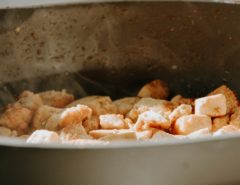By Allison Baker
Antioxidants have the ability to react with harmful radical molecules. In a more scientific definition, one researcher further characterizes this group of chemicals by stating “an antioxidant is a redox active compound that limits oxidative stress by reacting non-enzymatically with a reactive oxidant” (Blomhoff 2005). All this is to say that certain compounds have the ability to stabilize free radicals to some extent and thus reduce oxidative damage. Several of these antioxidant compounds are phenolics found in apples. A recent study demonstrated that in the United States, 22% of phenolics consumed from fruits are actually from apples (Vinson and others 2010). These compounds include quercetin-3-galactoside, quercetin-3-glucoside, quercetin-3-rhamnoside, catechin, picatechin, procyanidin, cyanidin-3-galactoside, coumaric acid, chlorogenic acid, gallic acid, and phloridzin (Boyer 2004).
Oxidative damage is linked to cardiovascular disease or hypertension due to atherosclerosis (Rakesh and others 2010). Specifically, relevant to heart disease, the procyanidins, epicatechin and catechin have been found to inhibit low density lipoprotein (LDL) oxidation in vitro (da SIlva Porto 2003). Since heart disease is the leading cause of death in America, it is not surprising that food companies have funneled resources into filling the need for foods that can help to eliminate at least some of this risk (CDC 2012). In order to understand the damage that oxidation can have and how it contributes to these health issues, we must first learn some free radical biology.
Free radicals are very reactive molecules that readily cause damage to other nearby molecules. During normal cellular respiration in the mitochondria (this is how our bodies break down glucose into energy), free radicals are formed (Blomhoff 2005). Free radicals are also introduced into our bodies as the result of inflammation, cigarette smoke, and radiation (Rakesh and others 2010). In the case of cardiovascular disease, this damage comes in the form of atherosclerosis. Low density lipoproteins, or LDL molecules, are the major carriers of cholesterol in our bodies. The term LDL itself comes from the ratio of lipid to protein in the molecule. In LDL, there are far more lipids than proteins. These lipids are very susceptible to damage from free radicals. Once oxidized, they can move into blood vessel walls. However, our natural immune response in which larger protective cells, or “phagocytes,” come to envelop and destroy this harmful material no longer operates efficiently. The phagocytes cannot break down these molecules. As a result, the oxidized LDL begins to build up and this causes thickening of the blood vessel walls. As the blood vessel walls thicken, the opening through which blood can flow becomes more and more restricted. This can cause other molecules to begin to accumulate in the vessel itself. This is called plaque. This leads to stress on the heart or hypertension and can ultimately result in complete blockage of that vessel. One way to combat this sequence of events is to provide our bodies with sufficient means by which to prevent as much of this damage as possible in the first place. Specific bioactive functional foods termed “antioxidants” serve this purpose.
Disclaimer: I am from Washington State where fresh apples are the 7th top export, so I may be biased. However, I am going to go ahead and say, the cliché “an apple a day keeps the doctor away” has some scientific footing in terms of providing an important source of antioxidants. So eat an apple!
References
Blomhoff R. 2005. Dietary Antioxidants and Cardiovascular Disease. Current Opinion in Lipidology. 16, no. 1: 47-54.
Boyer J, and RH Liu. 2004. Apple Phytochemicals and Their Health Benefits. Nutrition Journal. 3.
Chopra, Deepak. Weekly Health Tip: What Are So-Called ‘Functional Foods’? The Huffington Post. TheHuffingtonPost.com, 01 Aug. 2011. Web. 22 Apr. 2013.
Da SIlva Porto P, Laranjinha J, de Freitas V: Antioxidant protection of low density lipoprotein by procyanidins: structure/activity relationships. Biochem Pharmacol 2003, 66:947-954
Leading Causes of Death. Centers for Disease Control and Prevention. Centers for Disease Control and Prevention, 11 Jan. 2013. Web. 22 Apr. 2013.
Rakesh, Sachin Uttam, Priyanka R. Patil, and Sagar R. Mane. 2010. Use of Natural Antioxidants to Scavenge Free Radicals: A Major Cause of Diseases. International Journal of PharmTech Research. 2, no. 2.
Singer, Natasha. Foods with Benefits, or So They Say. Business Day. The New York Times, 14 May 2011. Web. 22 Apr. 2013.
State Exports for WASHINGTON. United States Census Bureau, 15 Mar. 2013. Web. 22 Apr. 2013.
Vinson J, Su X, Zubik L, Bose P: Phenol antioxidant quantity and quality in foods: fruits. J Agric Food Chem 2001, 49:5315-5321.
Photo Credit: http://behealthyascanbe.com/an-apple-a-day/





Leave a Reply